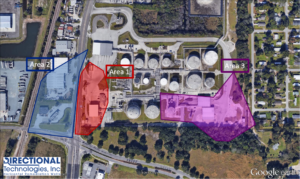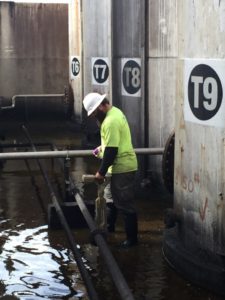A serious concern for environmental consultants and site operators is how to safely conduct work within high risk areas and exclusion zones of active remediation sites. High risk areas such as tank basins, pipeline right-of-ways, UST beds, and high traffic areas present numerous safety hazards for site personnel. These areas are often difficult if not impossible to access with traditional drilling techniques. Consultants tasked with in-situ remediation of these areas are often frustrated and discouraged since it can be difficult to formulate a safe and efficient plan for remediation solutions for their clients.
Installation of horizontal remediation wells (HRWs) with horizontal directional drilling (HDD) technology significantly decreases high risk area hazards when compared with traditional drilling methods.
HRWs can be installed beneath a no access zone from a safe location and distance to treat the area of concern. Our technology is highly regarded within the environmental industry for its safety benefits. Safety hazards encountered on active remediation sites can be mitigated or eliminated when HRWs are selected as the remedial method.
Reduce the Need to Enter the Exclusion Zone/High Risk Area
HRWs reduce the need to access high traffic area.
When installing a horizontal well system for a remediation site, the directional drilling equipment and team are frequently staged in a peripheral location, out of the way of site traffic patterns. Whether drilling beneath a busy roadway, parking lot, railyard, or runway, HDD technology enables for installation of HRWs beneath high traffic areas from a safe location. Whereas safely accessing these areas with a vertical drill rig requires traffic control plans, road closures, and potential business closures.

HRWs can be installed beneath active AST and UST storage areas.
Drilling within an active AST or UST storage area via vertical drilling comes with serious health and safety concerns. Active AST basins are difficult and dangerous to physically enter with a vertical drill rig. Above and below ground transfer piping presents additional hazards. Directional Technologies has safely installed dozens of horizontal wells to successfully remediate beneath AST and UST storage areas.

Other Safety Benefits of Horizontal Remediation Wells
Installation of HRWs results in less trenching.
Installation of remediation systems commonly includes trenching for placement of conduit and piping. Trenching equipment such as walk-behind saw cutters, backhoes, and track-hoes create operational hazards. Installation of HRWs with HDD technology can substantially diminish the need for trenching, which translates into risk reduction. Fewer open trenches mitigates slip/trip/fall hazards. Additionally, less saw cutting and excavating at a site results in less opportunity for an accident to occur.
Horizontal directional drilling is a safe, hands free process.
The horizontal directional drill rig is an advanced piece of equipment with safety built into the design. All mechanical functions of the rig including rod connections and boom movement are remotely controlled from the drilling operators cabin/control seat. A drill helper is not required for drilling functions, which keeps personnel away from pinch points and rotational hazards.
The final HRW product is safer for environmental field personnel.
Environmental field personnel are routinely required to enter high traffic areas to access vertical remediation wellheads and sparge points for maintenance, adjustments, and data collection. HRWs provide a unique advantage as the permanent wellheads are located near the points of entry of the wells and are typically located on the periphery of the site. The safer locations of the HRW vaults and well heads cut down on time spent by the field personnel in high risk/high traffic areas.
Do you have a site where access to the treatment area is a challenge? The engineers and geologists at Directional Technologies are available and ready to help you plan your next project. Take advantage of the versatility of horizontal remediation wells to access beneath high risk zones.